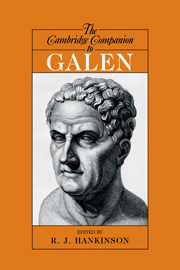Book contents
- Frontmatter
- 1 The man and his work
- 2 Galen and his contemporaries
- 3 Methodology
- 4 Logic
- 5 Language
- 6 Epistemology
- 7 Psychology
- 8 Philosophy of nature
- 9 Anatomy
- 10 Physiology
- 11 Therapeutics
- 12 Drugs and pharmacology
- 13 Commentary
- 14 The fortunes of Galen
- Appendix 1: A guide to the editions and abbreviations of the Galenic corpus
- Appendix 2: English titles and modern translations
- Bibliography
- Index
13 - Commentary
Published online by Cambridge University Press: 28 September 2008
- Frontmatter
- 1 The man and his work
- 2 Galen and his contemporaries
- 3 Methodology
- 4 Logic
- 5 Language
- 6 Epistemology
- 7 Psychology
- 8 Philosophy of nature
- 9 Anatomy
- 10 Physiology
- 11 Therapeutics
- 12 Drugs and pharmacology
- 13 Commentary
- 14 The fortunes of Galen
- Appendix 1: A guide to the editions and abbreviations of the Galenic corpus
- Appendix 2: English titles and modern translations
- Bibliography
- Index
Summary
In his biobibliographical treatise, On My Own Books (Lib.Prop.), Galen categorizes a significant segment of his vast written array according to the past authority (or authorities) with whose works, or wider thought, they are engaged. The names of Hippocrates, Erasistratus, Asclepiades (of Bithynia), Plato, Aristotle and Epicurus, as well as the collectivities of the Empiricists, Methodists and Stoics, all appear in chapter headings as having attracted Galen's dedicated literary attention. Not all appear in the same light, however. Some – Erasistratus, the Empiricists, Methodists and Stoics – are critically identified, with Galen writing to differentiate himself from them; while the rest are referred to more neutrally, as having been written on, or about. The number, and type, of texts that come under each heading also varies considerably, and there are several cross-references to other categories in which the same treatise could (and sometimes does) also feature.
There is still more unevenness in terms of the survival of these texts, so that a distinctly (though revealingly) unrepresentative sample remains available for further study. It is worth, therefore, attempting to replace the extant portion of Galen's exegetical efforts within the wider patterns of his literary engagements with the works of others, before subjecting it to more detailed analysis; trying to get a sense of his interpretative project as a whole before focusing on its most historically successful products.
- Type
- Chapter
- Information
- The Cambridge Companion to Galen , pp. 323 - 354Publisher: Cambridge University PressPrint publication year: 2008
- 5
- Cited by

